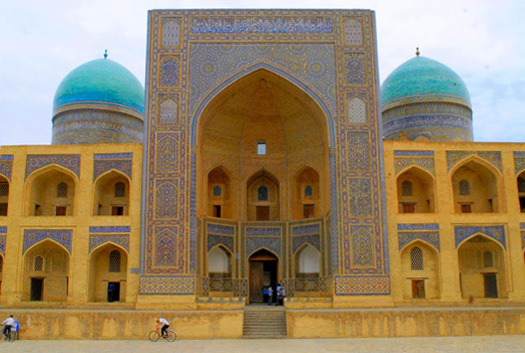
Mir-Arab Madrassah, Bukhara, Uzbekistan
“The World is a caravanserai, with one entry and one exit…”
— Omar Khayyam, 1048-1123
No one knows for sure when the Silk Road originated, but it’s provenance is well-documented: a trade link between China and the Mediterranean. Sericulture itself — which dates as far back as the Yangshao period (5000 – 10,000 BC) begins with the mystery of the Bombyz Mori, descended from a species of silkworm native to the Xi’an region of China — a domesticated, blind, flightless moth that only dwells in captivity, feasting on fresh mulberry leaves and thereby increasing its weight within its first 30 days by a factor of 10,000. Cultivating its fine silk has classically been perceived as a precious commodity, one which served to sustain the renowned Tang Empire’s remarkable wealth and aspirations as they traded silk for gold.
“The World is a caravanserai, with one entry and one exit…”
— Omar Khayyam, 1048-1123
No one knows for sure when the Silk Road originated, but it’s provenance is well-documented: a trade link between China and the Mediterranean. Sericulture itself — which dates as far back as the Yangshao period (5000 – 10,000 BC) begins with the mystery of the Bombyz Mori, descended from a species of silkworm native to the Xi’an region of China — a domesticated, blind, flightless moth that only dwells in captivity, feasting on fresh mulberry leaves and thereby increasing its weight within its first 30 days by a factor of 10,000. Cultivating its fine silk has classically been perceived as a precious commodity, one which served to sustain the renowned Tang Empire’s remarkable wealth and aspirations as they traded silk for gold.
The most enduring legacy of what some might call the original information highway lay in the exchange of ideas, technologies (for example, paper, printing, gun powder — all developed in China), religion and craft — modern perspectives that gradually flourished and influenced centuries of civilization. In Uzbekistan, desolate lands supported the confluence of Manichaeism, Nestorian Christianity, Islam and Sufi worship, Buddhism, Taoism, Judaism (so instrumental in the rise of the textile industry), Zoroastrianism, Confucianism, and Mongol empires, only to be smothered by the totalitarian rule of Tsarist, Soviet and post-Soviet Russia.
To detect any authentic remnants of these influences today in Uzbekistan is essentially impossible. The inner sanctums where Sufis and other religious mystics pondered esoteric teachings have vanished along with the hundreds of mosques, temples, churches and religious schools. There is little native craft in this area; what was once deemed indispensable — fabric for clothing and tents, metal work for weapons and tools, carpets and ceramics, among other artifacts — is today only manufactured for tourists. Even with a war zone just three hours away by car; even after generations of Soviet destruction of anything remotely related to religion and cottage industry; even with the recent UNESCO World Heritage site designation and accompanying danger of sanitizing the crumbling remains of century old madrassah and mosques (supplemented by American funds paying for military cargo support services); even with a post-Soviet totalitarian regime that is as ruthless as any in the world; even with all these troubling cross-currents, there is the opportunity to touch something ancient, some influence of a former era within ancient Bukhara, the fifth-largest city in Uzbekistan.
Most of the photographs here were taken shortly after dawn in a small outdoor market. There, on carpets spread throughout a dusty plaza in the depth of the Old Town, awaits astonishing visual displays: ostentatious piles of lychees, Indian gooseberries, tangerines, plums, apricots and Hami melons, Turkish and Indian figs and a vast variety of seeds and nuts. Another vendor sells spices, homeopathic medicine and condiments — Mongolian rock salt, benzoin, cassia bark, sulfur, ginseng, castor bean, mint, asafetida resin and turmeric. One merchant’s carpet is artfully covered with aromatics: camphor, sandalwood, ambergris, myrrh, onchya, bdellium and storax bark. The faces of the vendors present what is most memorable: a sense of something private, enduring and uncorrupted. Historic patterns of color and design also survive into this, their modern life.
A more informed and detailed discussion of Uzbekistan craft can be found in the work of Christine Brown. She explains how Uzbek fashion is reasserting itself, most recently in an Oscar de la Renta collection. The American Museum of Natural History is currently offering an exhibit, “The Silk Road: Ancient Pathway to the Modern World” that literally offers a taste, scent, sound and feel of the region.

